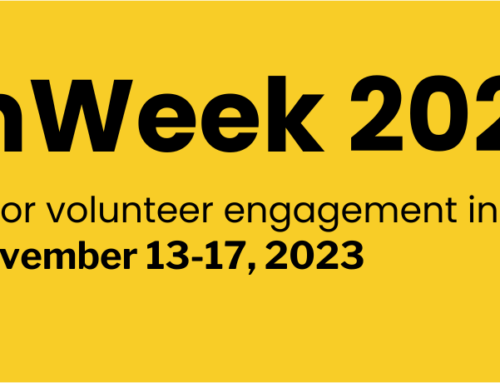Reduce Early Turnover with Better Volunteer Orientations
When you think about your new volunteer orientation, what images does it bring up?
Is it filled with people who are energized, engaged, and excited to meet one another and get started with your worthy cause?
Or does it feel more like a compliance exercise that checks the boxes and sometimes serves as a gatekeeper to inclusion?
Or is it somewhere in between?
And how do new supporters feel once they’ve completed their volunteer orientation with you?
Do they feel that they’ve just had a huge gulp from a firehose and aren’t sure which way is up? Or do they feel confident, secure, and ready to crush their new volunteer role alongside their team?
As leaders of volunteers, the way you design your volunteer orientations has everything to do with the next steps volunteers will take. These first experiences also often determine the initial depth of commitment a volunteer is ready to make.
The good news is that, as an “architect of the volunteer experience,” you get to choose.
You get to decide the mood, information, and outcomes of your new volunteer orientations based on what you decided to include and what you decided to leave out.
It all starts with understanding what onboarding is all about.
New Volunteer Onboarding: Planting Seeds for the Future
Many organizations focus on sharing rules and guidelines during their orientations and miss what’s going on under the surface.
More than your policies and procedures, volunteer onboarding is all about humans making meaning together, and involves a socialization process.
“Organizational socialization” is the work we all do to master the attitudes, values, knowledge and expected behaviors needed to participate as a loyal member of any group. It is how we learn to fit in.
In the human resources world, socialization is synonymous with terms such as assimilation, transition, alignment, induction, integration, onboarding and orientation — all related to helping new “hires” (paid or unpaid) get comfortable.
As such, volunteer orientation activities should be designed to help newcomers move smoothly through the process of socialization. The more connected they feel to the organization and the people in it, the greater likelihood they will become long-term contributing members of the team.
Volunteer programs often mistakenly institutionalize socialization by creating a single orientation event that is meant to shorten the time it takes to get volunteers acclimated.
The reality is that socialization is inherently slow. In fact, it can take over a year for full time employees.
Similarly, new volunteer orientation cannot occur during a single event either. Rather, it is a process of adaptation where volunteers experience a wide range of emotions internally — surprise, fear, ambiguity, etc. — while they wrestle with past and current expectations and make sense of an unfamiliar environment.
Want more orientation tips? Check out How to Boost the Power of Your Volunteer Orientation Process HERE >>
Rapid New Volunteer Orientation and Onboarding
So, what helps keep this process moving as quickly as possible, especially when the socialization process takes so long?
Volunteer orientation training can reduce the time, especially if it is helpful, supportive, makes social cues easy to read and fosters connections between newcomers, the organization and the people in it.
To help volunteers get up to speed more quickly, integrate orientation information — and opportunities for interaction with other volunteers and staff — before, during and after the formal orientation event.
Include orientation activities and information across the initial stages of the volunteer lifecycle – in the recruitment, screening, training and placement stages of the relationship with your volunteers. This will help solidify their connection with your organization and increase your chances of developing a mutually satisfactory partnership.
There are also specific, evidence-based tactics you can put to use to reduce the time it takes volunteers to get up to speed and feel like they are truly included as a contributing member of your team.
Below are six research-based practices to promote rapid onboarding:
1. Focus on the Collective Versus the Individual — Expose newcomers to common entry experiences with a group versus unique experiences in isolation from other new hires. Because volunteers need to be able to bond with others, it may be more helpful to schedule orientations at regular intervals when a critical mass is ready versus conducting them one-by-one or by directing volunteers to an online course that is completed in isolation.
2. Design Formal Versus Informal Orientation Activities — Use specifically designed activities and materials while segregating newcomers from incumbents, versus using no prepared materials and immediately mixing with existing volunteers (e.g., learning on the job). Throwing folks in to “sink or swim” isn’t helpful, nor are orientations that are conducted verbally without backup materials.
3. Provide Sequential Versus Random Opportunities to Learn — Communicate the sequence of discrete and progressive learning activities instead of an ambiguous or unknown sequence. During the screening process, provided volunteers with an explicit training plan that describes what will happen and by when.
4. Established a Fixed Versus a Variable Completion Time Frame — Communicate specific deadlines for completing each socialization step. Although “work-at-your-own-pace” orientations may seem tempting and responsive to volunteer needs, it may be more helpful to set up achievable deadlines for each step.
5. Use Mentors — Provide newcomers with access to experienced organizational members as role models or mentors. Buddy systems really work, and research shows that they are more helpful when a buddy is there to answer mundane everyday questions (like “where do I find the copy paper?”) as compared with conducting technical training on how to do assigned tasks.
6. Provide Positive Reinforcement — Provide newcomers with positive social support and affirm their personal characteristics as opposed to giving negative social feedback, at least until newcomers adapt. That said, volunteer recognition shouldn’t be reserved for volunteers who’ve been around awhile or relegated to your annual recognition event. Plan to build it into your orientation activities right from the start.
These are only a few ways to add structure, consistency, connection, and predictability to your induction process. This makes it easier for volunteers to feel secure that they are on the right road to making a difference.
Wondering what to include in your volunteer handbook? Check out our post How to Set Up a Volunteer Handbook That Fosters Engagement HERE >>
Is Volunteer Orientation Training Better Online or On Land?
After you’ve decided what to include in your new volunteer orientation journey, next you need to decide how and where they will take place. Will it occur online or on land?
Does technology hurt or help volunteer orientations? It’s a great question that all organizations should be asking.
In one study, online and in-person orientations were compared. Employees took part in either a group, social-based orientation session or an individual, computer-based session. They were then asked to complete a survey measuring the six content areas of organizational socialization (organizational goals and values, history, politics, language, people and performance ability).
Compared with employees who attended the social-based orientation session, those who were in the computer-based session reported lower levels of socialization in the content areas of people, politics and organizational goals and values, and no significant difference in the more information-based dimensions of history, language and performance ability.
This study showed that face-to-face training is more effective in helping newcomers identify with the organization and its people.
On the other hand, in terms of specific job tasks, online training may work just as well (provided it is well designed).
So, a blended model of learning that combines both online and in-person may be ideal, with time spent learning tasks in an online environment and socialization and values-based sharing occurring in person.
Although this may not always be possible for organizations to pull off, it is important to assess how training is going. Is it reaching the goals you hoped it would? Do volunteers feel connected and committed to your organization and one another? Are they clear and confident in their next steps and whether they are equipped to make a difference? What would they say to others about their experience?
These are all good things to ask on a post-volunteer orientation feedback survey, to decide what you need to adjust and where you need to double down when it comes to orientating new volunteers.
For more on improving your online training, check out 7 Deadly Sins to Avoid for Better Online Volunteer Training HERE >>
How to Encourage Deeper Volunteer Participation Right from the Start
Volunteer orientations are not simply about sharing policies and procedures and dos and don’ts.
They can also set the stage for deeper commitment by creating human connections and building confidence.
To help newcomers negotiate the unfamiliar waters of your organization, and to encourage deeper levels of participation, below are four specific support tactics that can be integrated into your volunteer orientation process to reduce turnover and improve your results.
1. Establish Predictable Rituals — Rituals increase feelings of safety and reinforce connections between the values of volunteer and organization. They can be a terrific way of reinforcing the interconnectedness of the team. Rituals don’t have to be complicated. They can be simple things you do at the beginning of a meeting or a shift that are expected and fun.
2. Encourage Peer-to-Peer Friendships— Relationships increase feelings of responsibility and commitment. In addition, both formal and informal peer mentoring and knowledge sharing help ease the burden of socialization. So, think about ways you can “sow the seeds” of better connections between volunteers.
3. Offer Formal Skills-based Training — Although most of what we learn is on the job, formal training can help increase self-confidence, connect the dots and provide a roadmap for organizational socialization. Even if the volunteer position isn’t highly technical, they still need to be oriented to how your organization does business and how to be a better ambassador for you in public. So, help them do so by investing in training.
4. Point Out Program Impact — Volunteers need to know that the hassle of learning the ropes at your organization is utterly worth it. Make sure you continue to talk about how your organization is making a difference and how they fit into the larger picture. In general, programs tend to share this information during the recruitment process, but arguably, volunteers need to hear more about your program’s effectiveness when they are on the fence about how much time and energy they will ultimately commit.
Here’s the bottom line – you spend a significant amount of time and energy recruiting volunteers. So, it makes sense to take care when designing your next volunteer orientation so that it meets the needs of both volunteers and your organization.
It should help build confidence and momentum toward service on the part of volunteers and increased confidence in volunteer abilities and commitment on the part of paid staff.
It should also be a place where people come together to forge new relationships across your organization that, when combined, create a force for the greater good.
When you achieve that end, your teams will be truly unstoppable.
Wondering how to Fund Your New Orientation Strategy?
Check Out Our Free VolunteerPro Training – How to Fund Your Volunteer Program
Move from surviving to thriving with targeted investments to fuel your nonprofit’s most critical goals.
Learn how to build a budget and fund it with six creative strategies to ensure your volunteer strategy has full support in our free training – How to Fund Your Volunteer Program.
In this free live online training, you’ll learn …
The #1 Mindset Shift
that separates thriving nonprofits from those that struggle to scale
What to Include, at Minimum, in Your Baseline Budget
and what it takes – in real terms – to build a thriving volunteer corps
Six Creative Ways to Fund Your Volunteer Programming
and “bake in” predictable revenue streams for your volunteer operations
How to Pitch Your Resource Needs to Funders
without the overwhelm and (fist pump!) actually saves you time!
How to Future-Proof Your Volunteer Strategy
so that it is sustainable and poised for growth
Two Dates to Choose From!
Thursday, May 19, 2pm ET/11am PT
OR
Tuesday, May 24, 1pm ET/10am PT










